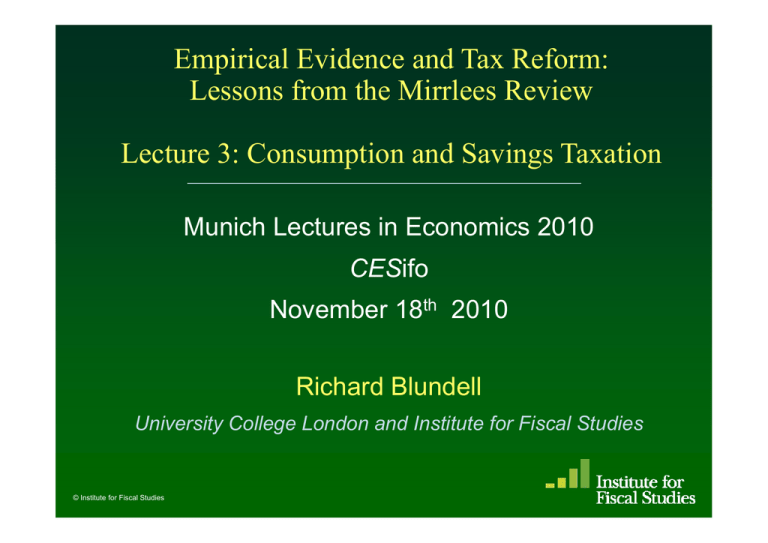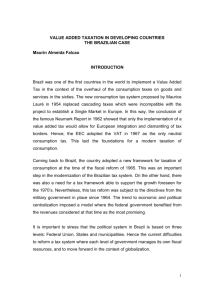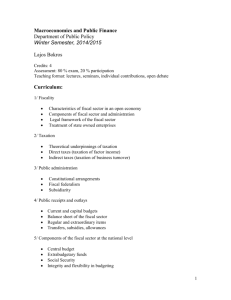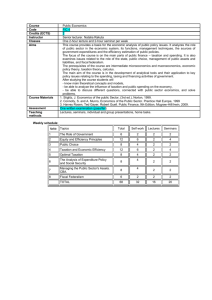Empirical Evidence and Tax Reform: Lessons from the Mirrlees Re ie
advertisement

Empirical Evidence and Tax Reform: Lessons from the Mirrlees Review Re ie L t Lecture 3 Consumption 3: C ti andd Savings S i Taxation T ti Munich Lectures in Economics 2010 CESifo November 18th 2010 Richard Blundell University College London and Institute for Fiscal Studies © Institute for Fiscal Studies Key Margins of Adjustment • Consumer demand responses – • Savings-pension portfolio mix – • CGT reforms and the non-alignment with labour income rates Organisational form – • ‘Life Life-cycle cycle’ accumulation of savings and pension contributions Forms of remuneration – • responses to differential taxation of across commodities UK chart on incorporations and tax reforms Draw on evidence from the Tax by Design – 20 chapters by the editors – and Dimensions of Tax Design (MR1) – all free on the web! Dimensions of Tax Design: commissioned chapters and expert commentaries (1) • • • The base for direct taxation James Banks and Peter Diamond;; Commentators: Robert Hall;; John Kay; Pierre Pestieau Means testing and tax rates on earnings Mike Brewer Brewer, Emmanuel Saez and Andrew Shephard; Commentators: Hilary Hoynes; Guy Laroque; Robert Moffitt Value added tax and excises Ian Crawford, Michael Keen and Stephen Smith; Commentators: Richard Bird; Ian Dickson/David White; Jon Gruber • E i Environmental t l ttaxation ti Don Fullerton, Andrew Leicester and Stephen Smith; Commentators: Lawrence Goulder;; Agnar g Sandmo • Taxation of wealth and wealth transfers Robin Boadway, Emma Chamberlain and Carl Emmerson; C Commentators: H l Helmuth hC Cremer; Th Thomas Pik Piketty; M Martin i W Weale l Dimensions of Tax Design: commissioned chapters and expert commentaries (2) • • International capital taxation Rachel Griffith, James Hines and Peter Birch Sørensen; Commentators: Julian Alworth; Roger Gordon and Jerry Hausman Taxing corporate income Alan Auerbach, Al A b h Mike Mik D Devereux and dH Helen l Si Simpson; Commentators: C t t Harry Huizinga; Jack Mintz • Taxation of small businesses Claire Crawford and Judith Freedman • The effect of taxes on consumption p and saving g Orazio Attanasio and Matthew Wakefield • Administration and compliance, p , Jonathan Shaw,, Joel Slemrod and John Whiting; Commentators: John Hasseldine; Anne Redston; Richard Highfield • Political economy of tax reform, reform James Alt Alt, Ian Preston and Luke Sibieta; Commentator: Guido Tabellini Consumer demand behaviour • Three key empirical observations: • N Non-separabilities biliti with ith llabour b supply l are iimportant t t • • – but mainly for childcare and work related expenditures – updated evidence in the Review Price elasticities differ ff with total expenditure/wealth / – responses p and welfare impact p differs across the distribution – new evidence shows compensation and welfare losses vary across the distribution Issues around salience of indirect taxes – Chetty et al (AER) Savings and Pensions • When the life-cycle model works – How much life-cycle y consumption/needs p smoothing gg goes on? 700 3.5 600 3 500 25 2.5 400 2 300 1.5 200 Net Income Per H Household h ld (LH A Axis) i ) 1 100 Equivalent AdultsPer Household (RH Axis) 0.5 0 Equiva alent Adults s Per Househ hold Weekly Income (P Per Household) Net Income, Number of Equivalent Adults per Household 0 20 23 26 29 32 35 38 41 44 47 50 53 56 59 62 65 68 71 74 77 Age of Head Source: UK FES 1974-2006 Consumption and Needs 3.5 600 Equivilised Non-Durable Expenditure (LH Axis) 3 500 Equivalent AdultsPer Household (RH Axis) 2.5 400 2 300 1.5 200 1 100 0.5 0 Numbe er of Equiv valent Adullts Per Hous sehold Equiv vilised Non--Durable Ex xpenditure e (Per Equivalent Adu ult) 700 0 20 23 26 29 32 35 38 41 44 47 50 53 56 59 62 65 68 71 74 77 A off H Age Head d Source: UK FES 1974-2006 Savings and Pensions • How much H h lif life-cycle l consumption/needs ti / d smoothing thi goes on? • - permanent/ t/ transitory t it shocks h k to t income i across wealth lth distribution (Blundell, Pistaferri and Preston (AER)) • - consumption and savings at/after / f retirement (BBT ( ( (AER)) )) • - how well do individuals account for future changes? – UK pension reform announcements Attanasio & Rohwedder (AER) – Liebman, Luttmer & Seif (AER) • Intergeneration transfers - Altonji, Altonji Hayashi & Kotlikoff Kotlikoff, etc – More recent evidence on bequests Savings and Pensions • Temporal preferences, ability, cognition, framing.. – • Banks & Diamond (MRI chapter); Diamond & Spinnewijn Spinnewijn, Saez,.. Earnings/skill uncertainty – across life-cycle and business cycle – Role in dynamic fiscal policy arguments for capital taxation Kocherlakota; Golosov, Tsyvinski & Werning, .. Implications for Reform • Indirect Ta Taxation ation • Taxation of Savings • An integrated and revenue neutral analysis of reform… Two g good broad g guidelines for indirect taxation 1. Tax final consumption only • VAT generally achieves this • But stamp duties, business rates and VAT exemptions do not 2. Tax goods at the same rate • Complexity creates strong presumption against differentiation • There are sound economic efficiency arguments for differentiation • But case sufficiently strong in only a few cases ¾ Childcare, Childcare ‘sin sin taxes’ taxes ‘green green taxes’ taxes • Distributional arguments for differentiation are weaker © Institute for Fiscal Studies • Evidence on consumer behaviour => exceptions to uniformity – Childcare strongly complementary to paid work – Various work related expenditures (QUAIDS on FES, MRI) – Human capital expenditures – ‘Vices’: alcohol,, tobacco,, betting, g, possibly p y unhealthyy food have externality / merit good properties Î keep ‘sin taxes’ – Environmental externalities (three separate chapters in MRII) • These do not line up well with existing structure of taxes ⇒Broadening the base – many zero rates in UK VAT • Compensating losers, even on average, is difficult • Worry about work incentives too • Work with set of direct tax and benefit instruments as in earnings tax reforms Indirect Taxation – UK case Zero rated: Zero-rated: Food Construction of new dwellings Domestic passenger transport I t International ti l passenger transport t t Books, newspapers and magazines Children’s clothing Drugs ugs a and d medicines ed c es o on p prescription esc pt o Vehicles and other supplies to people with disabilities Cycle helmets Reduced-rated: D Domestic ti fuel f l and d power Contraceptives Children’s car seats Smoking g cessation p products Residential conversions and renovations VAT-exempt: Rent on domestic dwellings R t on commercial Rent i l properties ti Private education Health services Postal services Burial and cremation Finance and insurance © Institute for Fiscal Studies Estimated cost (£m) 11,300 8,200 2,500 150 1,700 1,350 1,350 ,350 350 10 2,950 2 950 10 5 10 150 3,500 200 300 900 200 100 4,500 Impact on budget share of labour supply Conditional on income and prices Bread and Cereals Negative Meat and Fish g Negative Dairy products Negative Tea and coffee Negative Fruit and vegetables Negative Food eaten out Positive Beer Positive Wine and spirits Positive Domestic fuels Negative Household goods and services Positive g Adult clothing Positive Childrens’ clothing Negative Petrol and diesel Positive Source: QUAIDS on UK FES, MRI VAT in the UK • UK zero-rates most food, water, reading matter, children’s clothes,… – Clearly for distributional, not efficiency, reasons Î should h ld b be ended d d – Other countries show that it is not inevitable • Reduced rate on domestic fuel looks p particularly y bad given environmental concerns • Exemptions violate both of our principles © Institute for Fiscal Studies Implicit carbon taxes, 2009-10 Excluding VAT subsidy of domestic energy Coal-generated electricity, business Gas-generated electricity, business Gas for heating, business Coal-generated electricity, domestic Gas-generated electricity, domestic Gas for heating, domestic £0 £10 £20 £30 £/tonne CO2 © Institute for Fiscal Studies £40 £50 Broadening the VAT base • We simulate removing almost all zero and reduced rates • Raises £24bn (with a 17.5% VAT rate) if no behavioural p response • Reduces distortion of spending patterns – With responses we find, could (in principle) compensate every household and have about £3-5bn welfare gain • On its own base broadening would be regressive and weaken work incentives • Can a p practical p package g avoid this? © Institute for Fiscal Studies We illustrate one way of using the money: • Automatic 3.4% indexation of all tax thresholds and benefit rates rates. Plus Plus… • Extra 3.4% means-tested benefits, 2% state pension, i 10% child hild b benefit fit • £1,000 increase in income tax allowances • £4,530 cut in income tax basic rate limit and NIC upper earnings limit • 2p cut in basic rate, 1½p cut in higher rate, of income tax © Institute for Fiscal Studies VAT reform: f effects ff t by b income i % rise in non-housing g expenditure p % rise in income 8% 7% 6% 5% % 4% 3% 2% 1% 0% Poorest 2 3 4 5 6 7 Income Decile Group © Institute for Fiscal Studies 8 9 Richest VAT reform: f effects ff t by b expenditure dit % rise in non-housing expenditure cash h gain/loss i /l (£/ (£/week, k RH axis) i ) % rise in income 8% £8 7% £6 6% £4 5% % £2 £ 4% £0 3% -£2 2% -£4 1% -£6 0% -£8 Poorest 2 3 4 5 6 7 Expenditure Decile Group © Institute for Fiscal Studies 8 9 Richest VAT reform: incentive to work at all 35% 40% 45% 50% 55% 5 Participation tax rates 0 100 200 300 400 500 600 700 800 900 1000 1100 1200 Employer cost (£/week) Before reform © Institute for Fiscal Studies After reform VAT reform: incentive to increase earnings g 40% 45% 50% 55% 60% 6 Effective marginal tax rates 0 100 200 300 400 500 600 700 800 900 1000 1100 1200 Employer cost (£/week) Before reform © Institute for Fiscal Studies After reform Broadening the base of indirect taxation • Empirical results suggest current indirect tax rates do not line up with any reasonable justification and are a poor way of delivering redistribution given the other tax instruments available – Interpretation of results is that we can implement a reform package p g manages g to achieve compensation p while also avoiding significant damage to work incentives. – On average the EMTR rise by less than a quarter of a percentage point and the PTR by less than half a percentage point. – little change in work incentives at any earnings level • Quite sizable welfare gains from removing distortions => Welfare gains - Distribution of EV/x by ln(x) ln x Source: MRII The shape of a reform package • Broaden VAT base – keep p childcare differentiation,, sin taxes + reformed environmental taxes, etc • Reforms to the income tax / benefit rate schedule – Integrated benefit – Apply A l llessons ffrom empirical i i l evidence id on response elasticities l ti iti – Compensate for distributional effects of reform package • Interaction with taxation of corporate profits and the taxation of saving Guiding Principles on taxation of savings • Minimise distortions to decisions about when to consume • Life-cycle perspective: saving = deferred consumption • Treat different forms of saving g and investment in similar ways • Avoid sensitivity to rate of inflation The Taxation of Saving • Organising principal around which we begun was the ‘expenditure expenditure tax’ tax as in Meade/Bradford but with adaptations – coherent h t approach h tto taxation t ti off earnings i and d savings i over the life-cycle – lifetime base – provides id a fframework k ffor the th integration i t ti off capital it l income i taxation with corporate taxation – capital gains and dividends treated in the same way and overcomes ‘lock-in’ incentive from CGT – can incorporate progressivity and captures excess returns The Taxation of Saving • taxing saving is an inefficient way to redistribute - assuming that the decision to delay consumption tells us nothing about ability to earn • implies zero taxation of the normal return to capital – can be achieved through various alternative tax treatments of savings – but not a standard income tax Taxing Capital Gains • Taxing capital gains only on realisation fa o rs gains o favours over er cash income (e (even en if realised gains taxed at full marginal rates) • Tax deferral on accrued gains → lock-in effect • Incentives to convert income into capital gains – complex anti-avoidance provisions • T Taxing i capital it l gains i on an accrual-equivalent l i l t basis is theoretically possible, but never i l implemented t d iin practice ti Neutral Taxation of Savings • We discuss two alternatives to a standard income tax which avoid intertemporal distortion – expenditure tax – (Normal) Rate of Return Allowance • These two approaches are broadly equivalent • Both also treat cash income and capital gains equally, and avoid sensitivity to inflation Neutral Taxation of Savings g • Expenditure tax (EET) – tax relief for inflows – tax all outflows – cf. approx. current treatment of pensions • Rate of Return Allowance (RRA) – no tax relief for inflows – tax relief for normal component of returns – cf. similar to an ACE corporation tax – captures ‘excess returns’ Fraction of wealth held in different tax treatments in UK Decile of gross financial wealth Range of gross financial wealth (£’000s) (£ 000s) Private pensions ISAs Other assets Poorest <1.7 0.126 0.091 0.783 2 1.7–16.6 0.548 0.138 0.315 3 16.6–39.1 0.652 0.110 0.238 4 39.1–75.9 0.682 0.108 0.210 5 75.9–122.3 0.697 0.079 0.223 6 122.3–177.2 0.747 0.068 0.185 7 177 2 245 4 177.2–245.4 0 781 0.781 0 062 0.062 0 157 0.157 8 245.4–350.3 0.818 0.046 0.136 9 350.3–511.2 0.790 0.057 0.153 Richest >511.2 0.684 0.044 0.273 0.736 0.055 0.209 All Proportion of wealth held in: Source: ELSA, 2004 – at least one member aged 52-64 Unfortunately… Conditions for zero rate on normal return can fail if: 1. Heterogeneity (e.g. high ability people have higher saving rates) – new evidence and theory, Banks & Diamond (MRI); Laroque, Gordon & Kopczuk; Diamond & Spinnewijn; … 2 Earnings 2. E i risk i k and d credit dit constraints t i t – new theory and evidence on earnings ability risk, Golosov, Tsyvinski & W i Werning; Bl Blundell, d ll P Preston t & Pi Pistaferri; t f i C Conesa, Kit Kitao & K Krueger – e.g. keep wealth low to reduce labour supply response, weaken incentive compatibility constraint 3. Outside (simple) life-cycle savings models - myopia; self-control problems; framing effects; information monopolies 4. Non-separability (timing of consumption and labour supply) 5. Evidence suggests a need to adapt standard expenditure tax arguments But correct some of the obvious defects: • Capture excess returns and rents – move to RRA(TtE) or EET where possible – neutrality across assets – TEE limited largely to interest baring accounts – Lifetime accessions tax across generations, if practicable. practicable • Pensions - allow some additional incentive to lockin savings – twist implicit retirement incentives to later ages – current tax free lump sum in UK is too generous and accessed too early Interaction with Corporate Taxation • A progressive rate structure for the shareholder income tax, rather than the flat rate p proposed p by y GHS in MRI – with progressive tax rates on labour income, progressive rates are also a so required equ ed o on sshareholder a e o de income co e to oa avoid odd differential e e a tax a treatments of incorporated and unincorporated firms – • Suitable rate alignment g between tax rates on corporate p income, shareholder income and labour income – • a lower p progressive g rate structure on shareholder income than on labour income reflects the corporate tax already paid exempt p normal rate to g give neutrality y between debt and equity q y Note that current rates in UK on labour income (top 45%) and capital gains (18%)! © Institute for Fiscal Studies Empirical Evidence and Tax Policy Design: L Lessons ffrom th the Mi Mirrlees l R Review i Five building blocks for the role of evidence in tax design design…. • Key margins of adjustment to tax reform • Measurement of effective tax rates • Th importance The i t off information, i f ti complexity l it and d salience li • Evidence on the size of responses • Implications for tax design see http://www.ifs.org.uk/mirrleesReview © Institute for Fiscal Studies VAT and financial services • Consumption of financial services should be taxed • Exemption causes serious problems – Financial services too cheap for households, too expensive for firms – Costs around £7bn (though insurance premium tax recoups £2bn) • Can’t be taxed through standard VAT mechanism • But B t there th are equivalent i l t alternatives lt ti – Cash-flow tax, Tax Calculation Accounts, Financial A ti iti T Activities Tax,... • Need detailed study to find the most practical option © Institute for Fiscal Studies Congestion charging • Congestion charging could have big benefits – Government estimates p potential welfare g gains at 1% of national income • In contrast, fuel duty and vehicle excise duty not well targeted – But far too high to justify by carbon emissions alone • And will get even worse – Increased fuel efficiency; shift to electric cars? • National N ti l road d pricing i i should h ld replace l some off ffuell d duty t • A premium on acting quickly – Before lose what little we have – And while still a q quid p pro q quo to offer © Institute for Fiscal Studies But (too) many key issues unresolved, and with little evidence base (!) Including: • Tax credits and earnings progression • Distinction between dynamic and static policies • Human capital investment bias and savings taxation • Some transition issues and capitalisation • …. T i consumption Taxing ti off housing h i services i • H Housing i should h ld b be ttaxed d lik like other th consumption ti – But not currently subject to VAT • Could either tax new build build, or stream of consumption • From where the UK starts, the latter makes more sense • Tax the annual consumption value of housing: substitute for VAT • Looks like a sensibly reformed council tax – Based on up-to-date p valuations ((rather than 1991 values)) – Proportional to values (rather than pointlessly regressive and banded) – No discounts for single occupancy (rather than 25% discount) • And replace stamp duty on housing in the process – Initially on a revenue-neutral basis © Institute for Fiscal Studies A ‘housing g services tax’ Note: rough guide only – see Chapter 16 for details £6,000 Council tax bill Housing services tax bill £5,000 £4,000 £3,000 £2,000 £ ,000 £1,000 £0 £0 £200,000 £400,000 £600,000 Current property value © Institute for Fiscal Studies £800,000 £1,000,000 Summaryy of main indirect tax recommendations • End almost all zero rates, reduced rates and exemptions in VAT – Use revenue to compensate poor and maintain work incentives • Apply equivalent taxes to financial services and housing – The former would remove the need for insurance premium tax – The latter would replace council tax and stamp duty on housing • Move towards consistent pricing of greenhouse gas emissions • Replace most of fuel duty with a national system of road pricing © Institute for Fiscal Studies Some Additional References: Banks, JJ., Blundell Banks Blundell, R R., and Tanner Tanner, S S. (1998) “Is Is there a retirement retirement-savings savings puzzle?”, American Economic Review, 88, 769 – 788. Besley, T. and S. Coate (1992), “Workfare Workfare versus Welfare: Incentive Arguments for Work Requirement in Poverty Alleviation Programs”, American Economic Review, 82(1), 249-261. Blundell, R. (2006), “Earned income tax credit policies: Impact and Optimality”, The 2005 Adam Smith Lecture, Labour Economics, 13, 423-443. Blundell, R Blundell R.W., W Duncan Duncan, A A. and Meghir Meghir, C C. (1998) (1998), "Estimating Labour Supply Responses using Tax Policy Reforms", Econometrica, 66, 827-861. Blundell, R Blundell R, Duncan Duncan, A A, McCrae McCrae, J and Meghir Meghir, C C. (2000) (2000), "The The Labour Market Impact of the Working Families' Tax Credit", Fiscal Studies, 21(1). Blundell, R. and Hoynes, H. (2004), "In-Work Benefit Reform and the Labour Market", in Richard Blundell, David Card and Richard .B. Freeman (eds) Seeking a Premier League Economy. Chicago: University of Chicago Press. Blundell, Bl d ll R R. and dM MaCurdy C d (1999) (1999), "L "Labour b Supply: S l A Review R i off Alt Alternative ti Approaches", in Ashenfelter and Card (eds), Handbook of Labour Economics, Elsevier North-Holland. Blundell, R., Meghir, C., and Smith, S. (2002), ‘Pension incentives and the pattern of early p y retirement’, Economic Journal, 112, C153–70. Blundell, R., and A. Shephard (2008), ‘Employment, hours of work and the optimal taxation of low income families’, IFS Working Papers , W08/01 Brewer, M. A. Duncan, A. Shephard, M-J Suárez, (2006), “Did the Working Families Tax Credit Work?”, Labour Economics, 13(6), 699-720. Card, David and Philip K. Robins (1998), "Do Financial Incentives Encourage Welfare Recipients To Work?", Research in Labor Economics, 17, pp 1-56. Chetty, R Chetty R. (2008) (2008), ‘Sufficient Sufficient statistics for welfare analysis: a bridge between structural and reduced-form methods’, National Bureau of Economic Research (NBER), Working Paper 14399 Diamond, P. (1980): "Income Taxation with Fixed Hours of Work," Journal of Public Economics, 13, 101-110. Eissa, Nada and Jeffrey Liebman (1996), "Labor Supply Response to the Earned Income Tax Credit", Quarterly Journal of Economics, CXI, 605-637. IImmervoll, ll H H. Kl Kleven, H H. K Kreiner, i C C, and dS Saez, E E. (2005) (2005), `W Welfare lf Reform R f in i European Countries: A Micro-Simulation Analysis’ Economic Journal. Keane, M.P. and Moffitt, R. (1998), "A Structural Model of Multiple Welfare Program g Participation p and Labor Supply", pp y International Economic Review, 39(3), 553-589. Kopczuk, W. (2005), ‘Tax bases, tax rates and the elasticity of reported income’, J Journal l off Public P bli E Economics, i 89 2093 89, 2093–119. 119 Laroque, G. (2005), “Income Maintenance and Labour Force Participation”, Econometrica 73(2), Econometrica, 73(2) 341-376 341-376. Mirrlees, J.A. (1971), “The Theory of Optimal Income Taxation”, Review of Economic Studies,, 38,, 175-208. Moffitt, R. (1983), "An Economic Model of Welfare Stigma", American Economic Review, 73(5), 1023-1035. Phelps, E.S. (1994), “Raising the Employment and Pay for the Working Poor”, American Economic Review, 84 (2), 54-58. Saez, E. (2002): "Optimal Income Transfer Programs: Intensive versus Extensive Labor Supply Responses," Quarterly Journal of Economics, 117, 1039-1073. Sørensen , P. B. (2009) “Dual income taxes: a Nordic tax system”, Paper prepared for the conference on New Zealand Tax Reform – Where to Next?. ETRs for basic-rate taxpayer (BRT) and higher-rate taxpayer (HRT) Asset Effective tax rate (%) BRT HRT ISA (cash ( h or stocks t k and d shares) h ) 0 0 Cash deposit account 33 67 E l Employee contribution t ib ti tto pension i (i (invested t d 10 years)) –21 21 –53 53 (invested 25 years) –8 –21 (invested 10 years) –115 –102 (invested 25 years) –45 –40 0 0 ((invested 10 yyears)) 10 35 (invested 25 years) 7 33 Employer contribution to pension Owner-occupied housing Stocks and sharesb © Institute for Fiscal Studies Effective tax rates on returns to pension saving Asset Effective tax rate (%) Employee contribution to a pension Tax rate in work Tax rate in retirement Basic rate ((20%)) Basic rate ((20%)) –21 Higher rate (40%) Higher rate (40%) –53 Higher rate (40%) Basic rate (20%) –122 Basic rate (20%) Pension credit taper (40%) Tax credit taper (59%) Basic rate (20%) –260 T credit Tax dit ttaper (59%) P Pension i credit dit ttaper (40%) –189 189 © Institute for Fiscal Studies 46






